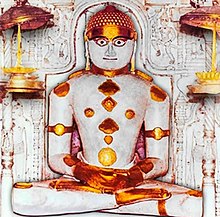| Tirthankara Rishabhanatha | |
|---|---|
1st Tirthankara | |
 | |
| Other names | Ādinātha, Ādeśvara (the first conqueror), Ādarśa Puruṣa (perfect man), Ikṣvāku |
| Venerated in | Jainism |
| Predecessor | Sampratti (last Tirthankara of the previous time-cycle) |
| Successor | Ajitanatha |
| Mantra | Oṃ Ṛṣabhadeva Namaḥ Oṃ Śrī Ādināthāya Namaḥ |
| Symbol | Bull |
| Height | 500 dhanuṣ (1,500 meters)[1] |
| Age | 8.4 million purvas (592.704 x 1018 years)[1][2][3] |
| Tree | Banyan |
| Color | Golden |
| Texts | Ādi purāṇa Mahāpurāṇa Bhaktāmara Stotra |
| Gender | Male |
| Festivals | Akshaya Tritiya |
| Genealogy | |
| Born | Ṛṣabha |
| Died | |
| Parents | |
| Spouse | Sumangalā Sunandā [4][5] |
| Children | • 100 sons (including: Chakravarti Bharata, Prince Nami, and Kamadeva Bahubali)
• 2 daughters: Mahasati Brāhmī and Mahasati Sundarī Reference:[6] |
| Part of a series on |
| Jainism |
|---|
 |

Rishabhanatha (Devanagari: ऋषभनाथ), also Rishabhadeva (Devanagari: ऋषभदेव, Ṛṣabhadeva), Rishabha (Devanagari: ऋषभ, Ṛṣabha) or Ikshvaku (Devanagari: इक्ष्वाकु, Ikṣvāku), is the first tirthankara (Supreme preacher) of Jainism.[7][8] He was the first of twenty-four teachers in the present half-cycle of time in Jain cosmology, and called a "ford maker" because his teachings helped one cross the sea of interminable rebirths and deaths. The legends depict him as having lived millions of years ago. He was the spiritual successor of Sampratti Bhagwan, the last Tirthankara of the previous time cycle.[6][9] He is also known as Ādinātha (lit. "first Lord"),[9] as well as Adishvara (first Jina), Yugadideva (first deva of the yuga), Prathamarajeshwara (first God-king) and Nabheya (son of Nabhi).[10][11] He is also known as Ikshvaku, establisher of the Ikshvaku dynasty. Along with Mahavira, Parshvanath, Neminath, and Shantinath, Rishabhanatha is one of the five Tirthankaras that attract the most devotional worship among the Jains.[12]
According to traditional accounts, he was born to king Nabhi and queen Marudevi in the north Indian city of Ayodhya, also called Vinita.[6] He had two wives, Sumangalā and Sunandā. Sumangalā is described as the mother of his ninety-nine sons (including Bharata) and one daughter, Brahmi. Sunandā is depicted as the mother of Bahubali and Sundari. The sudden death of Nilanjana, one of the dancers sent by Indra in his courtroom, reminded him of the world's transitory nature, and he developed a desire for renunciation.
After his renunciation, the legends as described in major Jain texts such as Hemachandra's Trishashti-Shalakapurusha-Charitra and Adinathcharitra written by Acharya Vardhamansuri state Rishabhanatha travelled without food for 400 days.[13][14][15] The day on which he got his first ahara (food) is celebrated by Jains as Akshaya Tritiya. In devotion to Rishabhanatha, Śvetāmbara Jains perform a 400-day-long fast, in which they consume food on alternating days. This religious practice is known as Varshitap. The fast is broken on Akshaya Tritiya.[16][17] He attained Moksha on Mount Asthapada (Kailash). The text Adi Purana by Jinasena, Aadesvarcharitra within the Trishashti-Shalakapurusha-Charitra by Hemachandra are accounts of the events of his life and teachings. His iconography includes ancient idols such as at Kulpak Tirth and Palitana temples as well as colossal statues such as Statue of Ahimsa, Bawangaja and those erected in Gopachal hill. His icons include the eponymous bull as his emblem, the Nyagrodha tree, Gomukha (bull-faced) Yaksha, and Chakreshvari Yakshi.
- ^ a b von Glasenapp 1925, p. 16.
- ^ Jacobi 1964, pp. 284–285.
- ^ Saraswati 1908, p. 444.
- ^ Jaini 2000, p. 327.
- ^ Champat Rai Jain 1929, p. 64-66.
- ^ a b c Dalal 2010b, p. 311.
- ^ Zimmer 1953, p. 208-09.
- ^ Sangave 2001, p. 131.
- ^ a b Britannica 2000.
- ^ Umakant 1987, p. 112.
- ^ Varadpande 1983, pp. 26–27.
- ^ Dundas 2002, p. 40.
- ^ Prakash ‘Babloo’, Dr Ravi (11 September 2021). Indian Philosophy and Religion. K.K. Publications.
- ^ Hendricks, Steve (6 September 2022). The Oldest Cure in the World: Adventures in the Art and Science of Fasting. Abrams. ISBN 978-1-64700-002-8.
- ^ Yatindrasuri, Acharya. "Rajendrasuri Smarak Granth". jainqq.org. Retrieved 31 May 2024.
- ^ Chambers, James (1 July 2015). Holiday Symbols & Customs, 5th Ed. Infobase Holdings, Inc. ISBN 978-0-7808-1365-6.
- ^ Fredricks, Randi (20 December 2012). Fasting: an Exceptional Human Experience. AuthorHouse. ISBN 978-1-4817-2379-4.